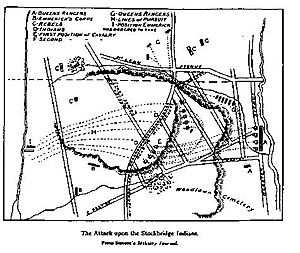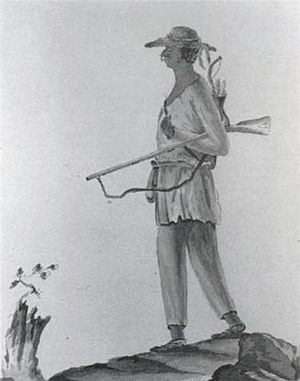Stockbridge Militia facts for kids
Quick facts for kids Stockbridge Militia |
|
|---|---|

Lt. Col. Simcoe's description of the battle. Woodlawn Cemetery is visible at bottom right.
|
|
| Active | 1775–1778 |
| Country | |
| Allegiance | |
| Branch | John Nixon's Brigade, 8th Massachusetts Regiment, Massachusetts Militia, Continental Army |
| Type | conventional soldiers, scouts |
| Role | conventional, 18th century, European warfare and scouting operations |
| Engagements | American Revolutionary War Siege of Boston |
| Commanders | |
| Notable commanders |
Major General Horatio Gates Brigadier General John Nixon Jehoiaikim Mtohksin (Stockbridge officer) Abraham Nimham (Stockbridge officer) |
The Stockbridge Militia was a special military group made up mostly of Native American warriors. They came from Stockbridge, Massachusetts. This unit fought alongside the Continental Army during the American Revolutionary War.
Most of the soldiers in the militia were from the Mohican, Wappinger, and Munsee tribes. These tribes lived in the Stockbridge area. While many other Native American tribes, like Joseph Brant's Mohawks, sided with the British, the Stockbridge tribes chose to support the American Patriots.
The Stockbridge Militia was led by two important officers: Jehoiaikim Mtohksin and Abraham Nimham. They were the first group of Native Americans to fight for American independence during the Revolutionary War.
Contents
Joining the Fight: Early Service in the Continental Army
In 1774, as the American Revolution was just beginning in Massachusetts, members of the Stockbridge tribes held a meeting. They met at the Red Lion Inn and promised to support the American cause. They said they would fight alongside the American armies. They also promised to never make peace with the British until the Americans did.
This first group of the Stockbridge Militia fought in two important battles in 1775. They were part of the Siege of Boston and the Capture of Fort Ticonderoga. After these battles, this early militia group broke up. Some of the Native American soldiers went home. Others continued to serve as scouts, helping different army units find their way and gather information.
Reforming the Militia: New Leaders and Battles
In 1777, a new Stockbridge Militia slowly came together. Stockbridge men who had been fighting in other units, like the 8th Massachusetts Regiment and Nixon's Brigade, joined forces. They gathered under the command of Major General Horatio Gates.
This new Stockbridge Militia was not as formally organized as some other army units. It became part of the Continental Army. Jehoiaikim Mtohksin led this group. Abraham Nimham, whose father Daniel Nimham was a famous Wappinger leader, became Mtohksin's second-in-command. From 1777 to 1778, this militia fought in several major battles. These included the Siege of Ticonderoga, the Battle of Saratoga, and the Battle of Monmouth.
The Stockbridge Massacre: A Tragic Battle
In August 1778, the Stockbridge Militia was stationed at an outpost. This outpost was in what is now the Bronx, just north of Manhattan. They were working with a new Light Infantry Corps. This corps was commanded by Continental Army General Mordecai Gist.
The Queen's Rangers attacked the Stockbridge Militia. The Queen's Rangers were a Loyalist military unit. Loyalists were Americans who supported the British king. Their commander was Lieutenant Colonel John Graves Simcoe. This attack became known by several names, including the Battle of Kingsbridge, Cortlandt Ridge, Van Cortlandt's Woods, or The Stockbridge Massacre.
The Battleground and Its Outcome
The Queen's Rangers were a special unit. They were formed from a group called Rogers' Rangers. Many Stockbridge Native Americans had actually served in Rogers' Rangers during the French and Indian War.
The battle happened in the northeast part of what is now Van Cortlandt Park. This area is still known today as "Indian Field." It is about one mile north of Kingsbridge in Bronx. The Queen's Rangers used a cavalry charge, where soldiers on horseback rode quickly into battle. This charge scattered the Stockbridge Militia.
Most reports say that about 40 Stockbridge Militia members were killed in this battle. The Queen's Rangers had very few casualties. Only 1 cavalryman was killed, and 3 were wounded. Because the battle was so chaotic, the Stockbridge Militia could not bury their dead. However, local residents soon searched the battlefield and buried any bodies they found.
What a Stockbridge Soldier Looked Like
After the battle, a Hessian captain named Johann Von Ewald drew a picture of a Stockbridge warrior. He based his sketch on one of the dead soldiers left behind. This drawing is the only known picture from that time showing a Stockbridge militiaman from the Revolutionary War.
Von Ewald described the Native American soldiers after looking at them closely:
- They wore a shirt made of rough linen that reached their knees.
- They had long linen trousers that went down to their feet.
- On their feet, they wore shoes made of deerskin.
- Their heads were covered with hats made from plant fibers.
- Their weapons included a rifle or musket, a bag with about twenty arrows, and a short battle-axe. They were very skilled at throwing these axes.
- They wore rings through their noses and in their ears.
- On their heads, they shaved off most of their hair. They only left a small circle of hair on top, about the size of a dollar coin.
- They used tweezers to pull out all their beard hair and other body hair.
The bodies of the Native American soldiers were left on the battlefield. Later, local people buried them in a large grave. In the 1800s, people said that the spirit of their leader, or sachem, haunted the land of "Indian Field."
Heavy Losses and the End of Service
The battle in the Bronx was the last time the Stockbridge Militia fought in the war. Abraham Nimham's father, Daniel Nimham, was a very respected leader among the Wappinger people. The deaths in the battle were a huge loss for the tribe back in Massachusetts.
The remaining company asked for permission to go home. They wanted to help the families of those who had died. In September 1778, George Washington ordered them to be paid $1,000.00 for their service. Then, they were officially discharged from the army.
After the War: Stockbridge Veterans
After the war, many Native Americans from the Stockbridge community moved away. They went to a new community called Brothertown in New York.
Voting Rights and Relocation
Some historians believe that the Stockbridge Native Americans' service in the American Revolution helped them gain voting rights. In the new Commonwealth of Massachusetts, the first plan for the state's constitution did not allow Native Americans to vote. However, this plan was strongly rejected. The second plan gave all men the right to vote.
Most of the Native American survivors eventually settled in Oneida County, New York. Later, they were moved again to Wisconsin. There, they formed the Stockbridge-Munsee tribal reservation.


